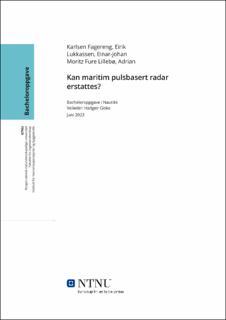| dc.contributor.advisor | Giske, Hallgeir | |
| dc.contributor.author | Karlsen Fagereng, Eirik | |
| dc.contributor.author | Lukkassen, Einar-Johan | |
| dc.contributor.author | Moritz Fure Lillebø, Adrian | |
| dc.date.accessioned | 2023-07-18T17:20:37Z | |
| dc.date.available | 2023-07-18T17:20:37Z | |
| dc.date.issued | 2023 | |
| dc.identifier | no.ntnu:inspera:146718194:151075497 | |
| dc.identifier.uri | https://hdl.handle.net/11250/3080027 | |
| dc.description.abstract | Gjennom denne bacheloroppgaven har det blitt undersøkt om det kan finnes bedre eller nyere teknologi som kan erstatte tradisjonell maritim pulsbasert radar. I teoridelen er det samlet informasjon om flere forskjellige radarteknologier og lignende teknologier, radarens virkemåte og bruksområde er beskrevet og relevante lover og regelverk er med.
Gruppen har valgt kvalitativ metode og utført flere intervju av eksperter på området. Kvalitativ metode ble valgt for å få en dypere forståelse av fagområdet og for å holde intervjuet åpent for innspill fra intervjuobjektene. Litteraturstudie foregikk på internett og i fagbøker. Mye av litteraturen kommer fra Norvald Kjerstad sin bok «Elektroniske og Akustiske Navigasjonssystemer».
Som fremtidige navigatører er gruppen opptatt av, og interesserte i teknologien som finnes, i tillegg til hvilken teknologi som kan bli aktuell i fremtiden. Derfor ble informasjonen fra litteraturstudie og resultatene fra intervjuene diskutert opp mot hverandre i diskusjonsdelen. Diskusjonen er et forsøk på å drøfte relevante spørsmål for å svare på problemstillingen. Gruppen har kommet til en konklusjon som tar utgangspunkt i hvordan ting er i dag. Konklusjonen kan muligens utfordres i fremtiden. | |
| dc.description.abstract | This bachelor's thesis examines the possibility of finding better or more advanced technology to replace traditional maritime pulse-based radar. The theoretical part gathers information on various radar technologies and similar technologies, describing the operation and application areas of radar, and includes relevant laws and regulations.
The qualitative method was chosen by the group, and multiple interviews with experts in the field were conducted. The qualitative approach was selected to gain a deeper understanding of the subject area and to allow for input from the interviewees during the interviews. The literature review was conducted using online sources and specialized books. Much of the literature used is derived from Norvald Kjerstad's book "Electronic and Acoustic Navigation Systems."
As future navigators, the group is concerned with and interested in the existing technology and the potential technologies that may become relevant in the future to ensure safe navigation. Therefore, the information obtained from the literature review and the interview results were discussed in relation to each other in the discussion section. The discussion aims to address relevant questions in order to answer the research question. The group has reached a conclusion based on the situation around maritime radar as it is today, which may be subject to change in the future. | |
| dc.language | nob | |
| dc.publisher | NTNU | |
| dc.title | Kan maritm pulsbasert radar ersattes? | |
| dc.type | Bachelor thesis | |
